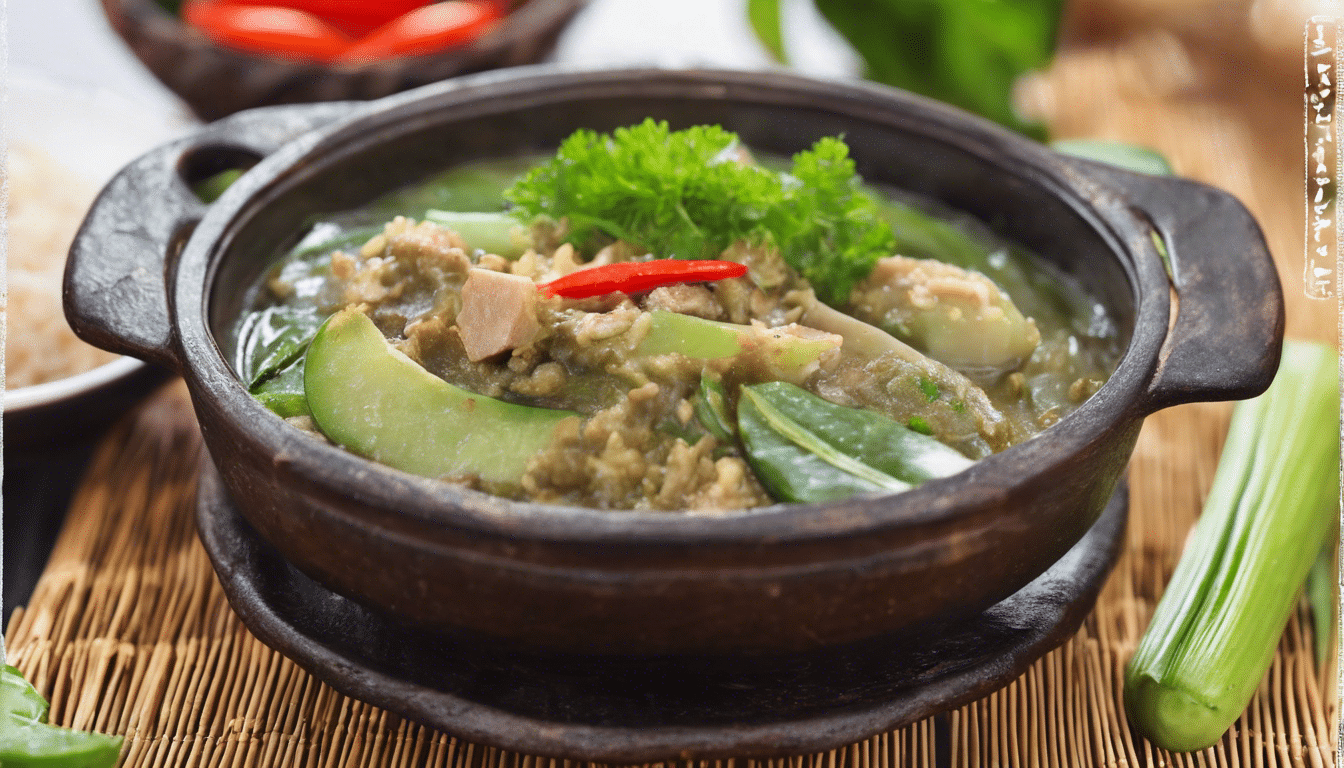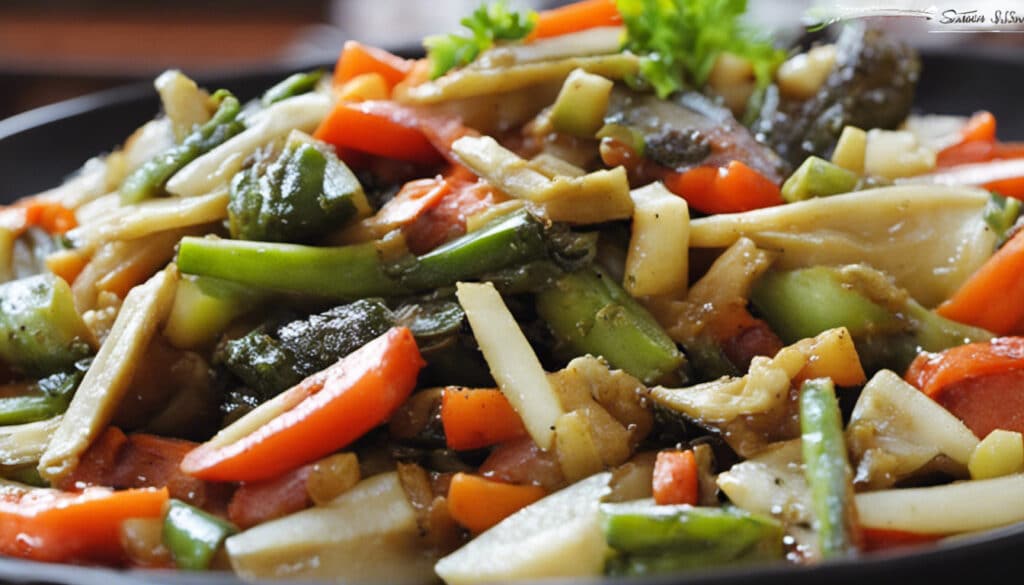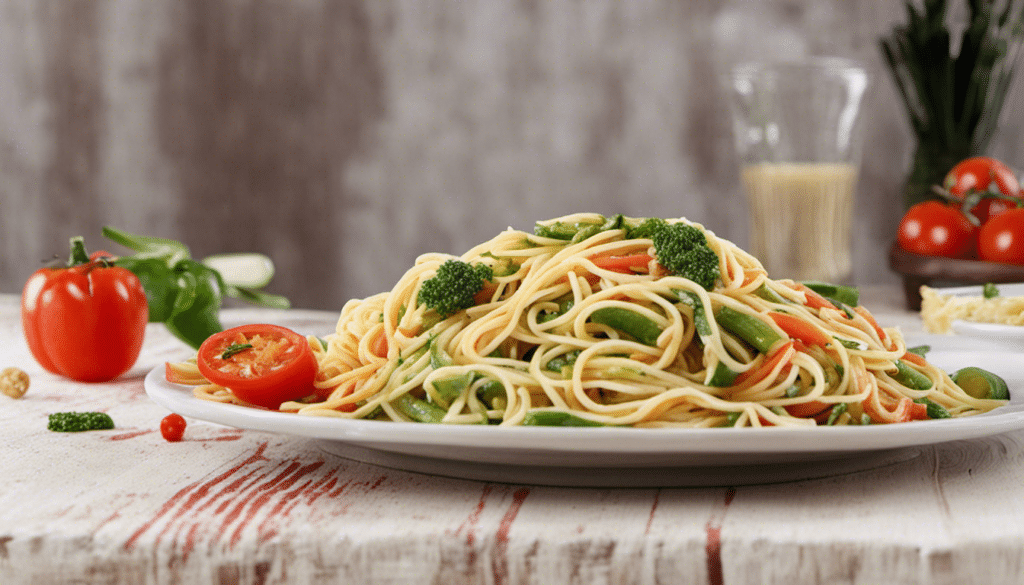| Prep: 20 mins | Cook: 15 mins | Difficulty: Easy | Serves: 6 |
| kcal | fat | saturates | carbs |
| 290 | 17g | 6g | 28g |
| sugars | fibre | protein | salt |
| 14g | 5g | 4g | 0.23g |
Why I Love Filipino Pininyahang Gulay
Embracing a Global Palate: Pininyahang Gulay
As a culinary connoisseur from Maine with an expertise in New England seafood, it might come as a surprise to some that one of my most beloved recipes hails from the Southeast Asian archipelago of the Philippines. But for me, the joy in cooking doesn’t just come from preparing familiar fare—it lies in the discovery of new flavors, techniques, and ingredients from all over the world. That’s why I can’t get enough of Pininyahang Gulay, an authentic Filipino recipe that is as vibrant and delicious as it is simple to prepare.
An Ode to Tropical Cuisine
Pininyahang Gulay is a stirring example of the delightful complexity of Filipino cuisine. Its name translates to “pineappled vegetables”, hinting at the refreshing, tangy flavor profile that makes this dish truly unique. Much like my favorite New England clam chowder, Pininyahang Gulay is a testament to its regional ingredients, making use of tropical staples like pineapple and coconut milk to elevate humble vegetables into a scrumptious, colorful stir-fry that’s perfect over a bowl of steaming rice.
The recipe was suggested by a dear friend of mine, internationally renowned chef Margarita Forés, whose passion for her Filipino roots often inspires her culinary masterpieces. Drawing from her encouragement, I tried my hand at Pininyahang Gulay, and as they say, the rest is history.
A Dish of Harmony and Balance
What truly enamors me about Pininyahang Gulay is its harmonious balance of flavors. The sweetness of pineapple coupled with the creamy richness of coconut milk, savory hit of soy sauce, and the slight crunch from an assortment of vibrant vegetables creates a symphony of tastes and textures that intrigues the palate with every bite. The optional addition of fresh cilantro garnish introduces an herbal nuance that further amplifies the dish’s tropical resonance.
This Filipino classic might remind you of a hearty vegetable stir-fry, or perhaps the sweet and sour dishes commonly found in Chinese cuisine. Moreover, Pininyahang Gulay pairs incredibly well with grilled seafood, making it a regular at my family dinners alongside grilled prawns or baked cod. After all, a touch of my New England roots never goes amiss.
From my kitchen in Portland, all the way to the lush landscapes of the Philippines, Pininyahang Gulay has been a culinary journey worth taking, one I’m excited to introduce to the readers of Your Gourmet Guru. Happy cooking!
What You’ll Need
- 2 tablespoons canola oil
- 1 large onion, chopped
- 3 cloves garlic, minced
- 1 large red bell pepper, seeded and chopped
- 1 large green bell pepper, seeded and chopped
- 2 medium carrots, peeled and sliced into thin rounds
- 1.5 cups green beans, trimmed and cut into 2 inch pieces
- 1.5 cups chopped pineapple
- 1 cup coconut milk
- 1 tablespoon soy sauce
- 1 teaspoon sugar
- 2 cups chopped cabbage
- Salt and pepper to taste
- Cooked rice for serving
- 1/4 cup chopped fresh cilantro for garnish (optional)
Method
Step One
Heat the canola oil in a large pan or wok over medium heat. Add the chopped onion and sauté until it becomes translucent.
Step Two
Add the minced garlic to the pan and cook until it becomes fragrant. This should take about a minute.
Step Three
Add the chopped red and green bell peppers to the pan along with the sliced carrots. Stir occasionally and cook for around 5 minutes, or until the vegetables begin to soften.
Step Four
Next, add the green beans and chopped pineapple to the pan. Stir the ingredients together and allow them to cook for another 5 minutes.
Step Five
Pour the coconut milk into the pan along with the soy sauce and sugar. Stir to combine, and then bring the mixture to a boil.
Step Six
Once the mixture has started boiling, reduce the heat to a simmer and add the chopped cabbage. Stir, cover the pan, and allow the mixture to simmer for 10 minutes.
Step Seven
Taste the vegetable mixture and add salt and pepper to your preference.
Step Eight
Serve the Pininyahang Gulay hot over cooked rice, garnish with chopped fresh cilantro if desired and enjoy!




